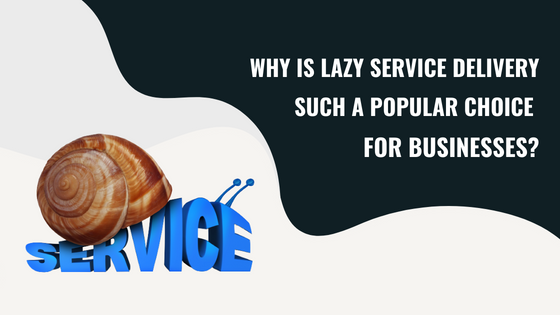Lazy service delivery is doing the minimum to keep customers “satisfied enough to not defect (as yet).”
I was marvelling at the rush of inspiration that accompanied the pandemic. So many businesses were motivated to do what needed to be done to ensure continuity. For one major reason. Their survival depended on making the essential shifts. Now, I know that this is both a human and a business trait. We act and we act with urgency, when there’s a crisis or when there’s a threat of disaster. Notwithstanding all of these norms, the question of why this rush of motivation has not been sustained, still stands.
When circumstances are not dire, speed and acceleration are not the “norm.” We settle into a rhythm that does not require too much exaggerated effort. We become okay with doing okay. It’s the same in the case of customer experience. Lazy service delivery is the parallel to being okay with okay.
The first thing to note about lazy service delivery is that often, it is driven by a set of malignant causes and issues that are deeply imbedded in the fabric of business culture and operations. Additionally, some businesses just don’t know how or where to start on their fixer-upper journey.
Lazy service delivery is doing the minimum to keep customers “satisfied enough to not defect (as yet).”
One of the most deep-seated malignancies that I’ve come across in businesses is “overwhelm.” Many businesses become so overwhelmed with the day to day activities of selling, producing and earning, that they fail spectacularly at ensuring that a stellar customer experience is sustained as a fundamental priority. Daily fire-fighting becomes the norm and superior service delivery is under-prioritized until it gets to a dangerously low level. Then of course, there’s a mad scramble to course correct and an equally frenzied effort to quick fix the service malfunctions.
May I suggest that any business that finds itself in this situation should pause and begin the journey of redesigning its blueprint for achieving service excellence?
When a business is overburdened with the wrong people that can spell danger to service excellence. The business runs the risk of overspending precious financial resources on employees who should not have been hired in the first place or, who, having been hired, have turned out to be a poor fit for the current operations and may be an even worse fit going forward. The longer these employees stay on board, the more they become a big risk to business success. To my mind, every business should have talent and people plans that mirror the dynamism of today’s evolving workplace and workspace.
The first thing to note about lazy service delivery is that often, it is driven by a set of malignant causes and issues that are deeply imbedded in the fabric of business culture and operations.
A notorious malignancy is the failure of businesses to track the cost of actual poor customer experience, as well as its attributable opportunity cost, or lost revenue. I evangelize about the benefits of tracking customer sentiment and customer disappointment as often as a business can do so. Conducting mystery shopper and customer sentiment surveys once a year, do not yield real-time intelligence that will enable a business to remediate customer pain issues expeditiously.
Another malignant issue is if the business has a pattern of not being innovative. How many businesses have innovation as a corporate value but fail to convert this value into a strategy that is deployed through programs and initiatives that result in convenience, time saving, speedy solutions and anticipation of customers’ needs? Possibly few.
Of course we know that online payment channels are no longer an innovation, they are now standard business features. Some innovations that would classify as customer swoon-worthy include end-to-end mobile transaction channels, customers logging in to a portal that gives updates on the status of their business transaction and Interactive Teller Machines (ITMs) that allow customers to toggle between self-service and human assistance.
Customers’ growing appetites for speed, convenience and choice are the markers for determining where they will be shopping next. Businesses that deliver innovations in response to these markers will be the heroes in the marketplace.
Customers’ growing appetites for speed, convenience and choice are the markers for determining where they will be shopping next. Businesses that deliver innovations in response to these markers will be the heroes in the marketplace.
We are living in a world where the “cancel culture” has become commonplace. The good news is that businesses have the opportunity to avoid being cancelled by their customers.
But, only if they change before they have to.

